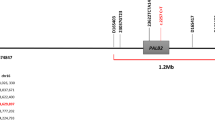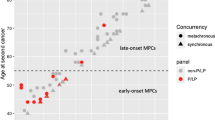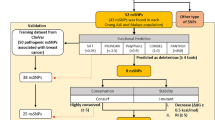Abstract
Gastric cancer is a serious health problem worldwide, with particularly high prevalence in eastern Asia. Genome-wide association studies (GWAS) in Asian populations have identified several loci that associate with gastric cancer risk. Here we report a GWAS of gastric cancer in a European population, using information on 2,500 population-based gastric cancer cases and 205,652 controls. We found a new gastric cancer association with loss-of-function mutations in ATM (gene test, P = 8.0 × 10−12; odds ratio (OR) = 4.74). The combination of the loss-of-function variants p.Gln852*, p.Ser644* and p.Tyr103* (combined minor allele frequency (MAF) = 0.3%) also associates with pancreatic and prostate cancers (OR = 3.81 and 2.18, respectively) and gives an indication of risk of breast and colorectal cancers (OR = 1.82 and 1.97, respectively). Cancers in those carrying loss-of-function ATM mutations are diagnosed at a significantly earlier age than in non-carriers. Our results confirm an association between gastric cancer in Europeans and three loci previously reported in Asians, MUC1, PRKAA1 and PSCA, refine the association signal at PRKAA1 and support a pathogenic role for the tandem repeat identified in MUC1.
This is a preview of subscription content, access via your institution
Access options
Subscribe to this journal
Receive 12 print issues and online access
$209.00 per year
only $17.42 per issue
Buy this article
- Purchase on Springer Link
- Instant access to full article PDF
Prices may be subject to local taxes which are calculated during checkout
Similar content being viewed by others
References
Ferlay, J. et al. Cancer incidence and mortality worldwide: sources, methods and major patterns in GLOBOCAN 2012. Int. J. Cancer 136, E359–E386 (2014).
Parkin, D.M., Stjernswärd, J. & Muir, C.S. Estimates of the worldwide frequency of twelve major cancers. Bull. World Health Organ. 62, 163–182 (1984).
de Martel, C., Forman, D. & Plummer, M. Gastric cancer: epidemiology and risk factors. Gastroenterol. Clin. North Am. 42, 219–240 (2013).
Hemminki, K., Sundquist, J. & Ji, J. Familial risk for gastric carcinoma: an updated study from Sweden. Br. J. Cancer 96, 1272–1277 (2007).
Study Group of Millennium Genome Project for Cancer. Genetic variation in PSCA is associated with susceptibility to diffuse-type gastric cancer. Nat. Genet. 40, 730–740 (2008).
Jia, Y. et al. A comprehensive analysis of common genetic variation in MUC1, MUC5AC, MUC6 genes and risk of stomach cancer. Cancer Causes Control 21, 313–321 (2010).
Abnet, C.C. et al. A shared susceptibility locus in PLCE1 at 10q23 for gastric adenocarcinoma and esophageal squamous cell carcinoma. Nat. Genet. 42, 764–767 (2010).
Shi, Y. et al. A genome-wide association study identifies new susceptibility loci for non-cardia gastric cancer at 3q13.31 and 5p13.1. Nat. Genet. 43, 1215–1218 (2011).
Jin, G. et al. Genetic variants at 6p21.1 and 7p15.3 are associated with risk of multiple cancers in Han Chinese. Am. J. Hum. Genet. 91, 928–934 (2012).
Lochhead, P. et al. Genetic variation in the prostate stem cell antigen gene and upper gastrointestinal cancer in white individuals. Gastroenterology 140, 435–441 (2011).
Sala, N. et al. Prostate stem-cell antigen gene is associated with diffuse and intestinal gastric cancer in Caucasians: results from the EPIC-EURGAST study. Int. J. Cancer 130, 2417–2427 (2012).
Palmer, A.J. et al. Genetic variation in C20orf54, PLCE1 and MUC1 and the risk of upper gastrointestinal cancers in Caucasian populations. Eur. J. Cancer Prev. 21, 541–544 (2012).
Gudbjartsson, D.F. et al. Large-scale whole-genome sequencing of the Icelandic population. Nat. Genet. 47, 435–444 (2015).
Kong, A. et al. Detection of sharing by descent, long-range phasing and haplotype imputation. Nat. Genet. 40, 1068–1075 (2008).
Sigurdardottir, L.G. et al. Data quality at the Icelandic Cancer Registry: comparability, validity, timeliness and completeness. Acta Oncol. 51, 880–889 (2012).
Holm, S. A simple sequentially rejective multiple test procedure. Scand. J. Stat. 6, 65–70 (1979).
Pruitt, K.D., Tatusova, T., Brown, G.R. & Maglott, D.R. NCBI Reference Sequences (RefSeq): current status, new features and genome annotation policy. Nucleic Acids Res. 40, D130–D135 (2012).
Saeki, N. et al. A functional single nucleotide polymorphism in mucin 1, at chromosome 1q22, determines susceptibility to diffuse-type gastric cancer. Gastroenterology 140, 892–902 (2011).
Ng, W., Loh, A.X.W., Teixeira, A.S., Pereira, S.P. & Swallow, D.M. Genetic regulation of MUC1 alternative splicing in human tissues. Br. J. Cancer 99, 978–985 (2008).
Carvalho, F. et al. MUC1 gene polymorphism and gastric cancer—an epidemiological study. Glycoconj. J. 14, 107–111 (1997).
Lange, L.A. et al. Whole-exome sequencing identifies rare and low-frequency coding variants associated with LDL cholesterol. Am. J. Hum. Genet. 94, 233–245 (2014).
Majithia, A.R. et al. Rare variants in PPARG with decreased activity in adipocyte differentiation are associated with increased risk of type 2 diabetes. Proc. Natl. Acad. Sci. USA 111, 13127–13132 (2014).
Liu, D.J. et al. Meta-analysis of gene-level tests for rare variant association. Nat. Genet. 46, 200–204 (2014).
Renwick, A. et al. ATM mutations that cause ataxia-telangiectasia are breast cancer susceptibility alleles. Nat. Genet. 38, 873–875 (2006).
Thompson, D. et al. Cancer risks and mortality in heterozygous ATM mutation carriers. J. Natl. Cancer Inst. 97, 813–822 (2005).
Roberts, N.J. et al. ATM mutations in patients with hereditary pancreatic cancer. Cancer Discov. 2, 41–46 (2012).
Li, A. & Swift, M. Mutations at the ataxia-telangiectasia locus and clinical phenotypes of A-T patients. Am. J. Med. Genet. 92, 170–177 (2000).
Toller, I.M. et al. Carcinogenic bacterial pathogen Helicobacter pylori triggers DNA double-strand breaks and a DNA damage response in its host cells. Proc. Natl. Acad. Sci. USA 108, 14944–14949 (2011).
Kong, A. et al. Parental origin of sequence variants associated with complex diseases. Nature 462, 868–874 (2009).
Li, H. & Durbin, R. Fast and accurate long-read alignment with Burrows-Wheeler transform. Bioinformatics 26, 589–595 (2010).
McKenna, A. et al. The Genome Analysis Toolkit: a MapReduce framework for analyzing next-generation DNA sequencing data. Genome Res. 20, 1297–1303 (2010).
DePristo, M.A. et al. A framework for variation discovery and genotyping using next-generation DNA sequencing data. Nat. Genet. 43, 491–498 (2011).
McLaren, W. et al. Deriving the consequences of genomic variants with the Ensembl API and SNP Effect Predictor. Bioinformatics 26, 2069–2070 (2010).
Flicek, P. et al. Ensembl 2012. Nucleic Acids Res. 40, D84–D90 (2012).
Devlin, B. & Roeder, K. Genomic control for association studies. Biometrics 55, 997–1004 (1999).
GTEx Consortium. The Genotype-Tissue Expression (GTEx) project. Nat. Genet. 45, 580–585 (2013).
Stacey, S.N. et al. Ancestry-shift refinement mapping of the C6orf97-ESR1 breast cancer susceptibility locus. PLoS Genet. 6, e1001029 (2010).
Acknowledgements
We thank the individuals who participated in the study and whose contribution made this work possible. We also thank the personnel at the recruitment center. We acknowledge the Icelandic Cancer Registry (ICR) for assistance in the ascertainment of patients with cancer.
Author information
Authors and Affiliations
Contributions
H.H., T.R., P.S. and K.S. designed the study and interpreted the results. H.S.O., J.G.J., L.T., K.A., A.H., T.J. and H.S. carried out the subject ascertainment, recruitment and collection of clinical data. H.H., T.R., A.S., S.N.S., A.J., L.l.R., J.G., H.J., A.O., O.T.M., G.M. and U.T. performed the sequencing, genotyping and expression analyses. H.H., A.G., D.F.G. and P.S. performed the statistical and bioinformatics analyses. H.H., T.R., P.S. and K.S. drafted the manuscript. All authors contributed to the final version of the manuscript.
Corresponding authors
Ethics declarations
Competing interests
H.H., T.R., A.S., S.N.S., A.J., L.l.R., J.G., H.J., A.O., A.G., O.T.M., G.M., D.H.G., U.T., P.S. and K.S. are all employees of deCODE Genetics/Amgen, Inc.
Integrated supplementary information
Supplementary Figure 1 Manhattan plots showing genome-wide association results for gastric cancer.
Results are shown for all variants with significance level P < 0.05 and imputation information greater than 0.8. The associations are based on two overlapping sets: (a) 2,500 gastric cancer patients and 205,652 controls (GC all) and (b) 2,043 verified gastric cancer adenocarcinomas and 202,533 controls (GC verified adenocarcinomas).
Supplementary Figure 2 Q-Q plots of the gastric cancer GWAS results.
The plots show uncorrected (red crosses) and corrected (using the method of genomic control; blue circles) χ2 statistics from the gastric cancer GWAS. The associations are based on two overlapping sets: (a) 2,500 gastric cancer patients and 205,652 controls (GC all; correction factor λg = 1.13) and (b) 2,043 verified gastric cancer adenocarcinomas and 202,533 controls (GC verified adenocarcinomas; correction factor λg = 1.11). Results are shown for variants that reached P < 0.05.
Supplementary Figure 3 Overview of associations in the region around ATM.
Black circles show –log10 P as a function of Build 36 coordinates for associations with gastric cancer for imputed SNPs and indels in Iceland. The associations are based on 2,500 gastric cancer patients and 205,652 controls (GC all). The vertical broken lines indicate the LoF variants p.Ser644* (P = 2.7 × 10−6) and p.Gln852* (P = 5.5 × 10−7). Genes are shown in blue, and recombination rates are reported in cM/Mb.
Supplementary Figure 4 Overview of associations in the ATM gene.
Black circles show –log10 P as a function of Build 36 coordinates for associations with gastric cancer for imputed SNPs and indels in Iceland. The associations are based on 2,500 gastric cancer patients and 205,652 controls (GC all). The vertical dashed lines indicate the LoF variants p.Tyr103* (P = 0.19), p.Ser644* (P = 2.7 × 10−6) and p.Gln852* (P = 5.5 × 10-7). Genes are shown in blue, and recombination rates are reported in cM/Mb.
Supplementary Figure 5 Age at diagnosis based on imputed genotype of ATM LoF mutations for all cancers except BCC.
The plot shows the distribution of age at diagnosis for chip-typed individuals for all cancers except basal cell carcinoma. The dashed blue line corresponds to chip-typed individuals who are not imputed carriers of ATM LoF variants; the solid red line corresponds to chip-typed individuals who are imputed carriers of ATM LoF variants.
Supplementary Figure 6 Age at diagnosis based on imputed genotype of ATM LoF mutations for prostate cancer.
The plot shows the distribution of age at diagnosis for chip-typed individuals with prostate cancer. The dashed blue line corresponds to chip-typed individuals who are not imputed carriers of ATM LoF variants; the solid red line corresponds to chip-typed individuals who are imputed carriers of ATM LoF variants.
Supplementary Figure 7 Age at diagnosis based on imputed genotype of ATM LoF mutations for breast cancer.
The plot shows the distribution of age at diagnosis for chip-typed individuals with breast cancer. The dashed blue line corresponds to chip-typed individuals who are not imputed carriers of ATM LoF variants; the solid red line corresponds to chip-typed individuals who are imputed carriers of ATM LoF variants.
Supplementary Figure 8 Age at diagnosis based on imputed genotype of ATM LoF mutations for gastric cancer.
The plot shows the distribution of age at diagnosis for chip-typed individuals with gastric cancer (2,500 gastric cancer patients and 205,652 controls (GC all)). The dashed blue line corresponds to chip-typed individuals who are not imputed carriers of ATM LoF variants; the solid red line corresponds to chip-typed individuals who are imputed carriers of ATM LoF variants.
Supplementary Figure 9 Age at diagnosis based on imputed genotype of ATM LoF mutations for pancreatic cancer.
The plot shows the distribution of age at diagnosis for chip-typed individuals with pancreatic cancer. The dashed blue line corresponds to chip-typed individuals who are not imputed carriers of ATM LoF variants; the solid red line corresponds to chip-typed individuals who are imputed carriers of ATM LoF variants.
Supplementary Figure 10 Age at diagnosis based on imputed genotype of ATM LoF mutations for colorectal cancer.
The plot shows the distribution of age at diagnosis for chip-typed individuals with colorectal cancer. The dashed blue line corresponds to chip-typed individuals who are not imputed carriers of ATM LoF variants; the solid red line corresponds to chip-typed individuals who are imputed carriers of ATM LoF variants.
Supplementary Figure 11 Regional plot and conditional analysis at the reported PSCA locus at 8q24 that replicates in Iceland.
Vertical dashed lines indicate the most significant variant at the locus, rs2920295[G] (P = 1.0 × 10−7, OR = 1.21), and the previously reported 5′ UTR variant rs2294008[T] in PSCA that associates with gastric cancer in Iceland (P = 2.4 × 10−7, OR = 1.21). The horizontal dashed line shows the P-value threshold for the locus. Black circles correspond to unadjusted P values; red crosses correspond to P values adjusted for rs2920295. The associations are based on 2,500 gastric cancer patients and 205,652 controls (GC all).
Supplementary Figure 12 Regional plot and conditional analysis at the reported PTGER4-PRKAA1 locus at 5p13.1 that replicates in Iceland.
Vertical dashed lines indicate the most significant variant at the locus, rs10036575[C] (P = 4.8 × 10−6, OR = 0.81), and the variant rs13361707[C] in PRKAA1 that was previously reported in the Han Chinese population and associated with gastric cancer in Iceland (P = 2.7 × 10−4, OR = 1.16). The horizontal dashed line shows the P-value threshold for the locus. Black circles correspond to unadjusted P values; red crosses correspond to P values adjusted for rs10036575. The associations are based on 2,500 gastric cancer patients and 205,652 controls (GC all).
Supplementary Figure 13 Regional plot and conditional analysis at the reported MUC1 locus at 1q22 that replicates in Iceland.
The vertical dashed line indicates the missense variant rs760077[A] in MTX1 (P = 1.1 × 10−9, OR = 0.79, AF = 35.1%, p.Thr63Ser). The horizontal dashed line shows the P-value threshold for the locus. Black circles correspond to unadjusted P values; red crosses correspond to P values adjusted for rs760077. The associations are based on 2,500 gastric cancer patients and 205,652 controls (GC all).
Supplementary Figure 14 eQTL analysis for rs2294008 and the expression of PSCA in stomach.
The alternative allele of rs2294008 is the risk allele for gastric cancer; thus, the risk allele associates significantly with increased expression of PSCA (P = 3 × 10−13). The plot and data are taken from GTEx (http://www.gtexportal.org/home/eqtls/calc?tissueName=Stomach&geneId=ENSG00000167653.4&snpId=rs2294008; accessed 28 October 2014).
Supplementary information
Supplementary Text and Figures
Supplementary Figures 1–14, Supplementary Tables 1–18 and Supplementary Note. (PDF 2498 kb)
Rights and permissions
About this article
Cite this article
Helgason, H., Rafnar, T., Olafsdottir, H. et al. Loss-of-function variants in ATM confer risk of gastric cancer. Nat Genet 47, 906–910 (2015). https://doi.org/10.1038/ng.3342
Received:
Accepted:
Published:
Issue Date:
DOI: https://doi.org/10.1038/ng.3342
This article is cited by
-
Association of PTGER4 and PRKAA1 genetic polymorphisms with gastric cancer
BMC Medical Genomics (2023)
-
LINC00240 in the 6p22.1 risk locus promotes gastric cancer progression through USP10-mediated DDX21 stabilization
Journal of Experimental & Clinical Cancer Research (2023)
-
Integrated multi-dimensional analysis highlights DHCR7 mutations involving in cholesterol biosynthesis and contributing therapy of gastric cancer
Journal of Experimental & Clinical Cancer Research (2023)
-
The prevalence of lynch syndrome (DNA mismatch repair protein deficiency) in patients with primary localized prostate cancer using immunohistochemistry screening
Hereditary Cancer in Clinical Practice (2023)
-
Deficit of homozygosity among 1.52 million individuals and genetic causes of recessive lethality
Nature Communications (2023)



